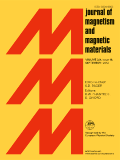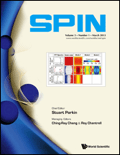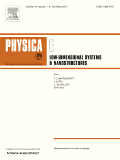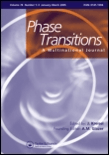
JOURNAL OF MAGNETISM AND MAGNETIC MATERIALS
metrics 2024
Pioneering Research in Magnetic Phenomena
Introduction
JOURNAL OF MAGNETISM AND MAGNETIC MATERIALS, published by Elsevier, stands at the forefront of research in the fields of magnetism and magnetic materials. With an established history since 1975 and a commitment to advancing knowledge through rigorous peer-reviewed studies, this journal has become a valuable resource for researchers and academics alike. Housed in the Netherlands and indexed under Scopus, it ranks Q2 in both Condensed Matter Physics and Electronic, Optical and Magnetic Materials, reflecting its impact within these domains. The journal aims to disseminate innovative research findings, methodologies, and reviews pertaining to magnetic phenomena, thus facilitating significant advancements in applications ranging from data storage technologies to medical imaging. While the journal does not feature open access options, it remains a vital part of the scientific dialogue, showcasing content that attracts a diverse audience, including researchers, professionals, and graduate students dedicated to enhancing their understanding of magnetism in various materials.
Metrics 2024
 0.52
0.52 2.50
2.50 2.50
2.50 195
195Metrics History
Rank 2024
Scopus
IF (Web Of Science)
JCI (Web Of Science)
Quartile History
Similar Journals

Computational Condensed Matter
Advancing the Frontiers of Condensed Matter PhysicsComputational Condensed Matter, a reputable journal published by Elsevier, serves as a critical platform for advancing the understanding of condensed matter physics and related fields. Since its inception in 2014, the journal has become a pivotal resource for researchers and professionals dedicated to exploring electronic, optical, and magnetic materials, as well as materials chemistry and general materials science. With its current standing in the Q3 quartile across multiple categories in 2023, it ranks within the 60th percentile for Materials Science (miscellaneous) and the 54th percentile for Condensed Matter Physics in Scopus, reflecting its growing influence and relevance in the scientific community. The journal aims to publish high-quality, peer-reviewed articles that can foster innovation and collaboration in computational methods applied to condensed matter systems. Researchers interested in cutting-edge insights and methodologies will find Computational Condensed Matter to be an invaluable addition to their academic resources. For those seeking to contribute to or stay informed about the latest advancements in the field, this journal is a must-read.

Journal of Advanced Dielectrics
Pioneering Research for Tomorrow's TechnologiesThe Journal of Advanced Dielectrics, published by World Scientific Publishing Co Pte Ltd, is a pivotal open-access platform since 2014 dedicated to advancing research in the fields of dielectrics, ceramics, and composites. Based in Singapore, this journal aims to bridge the gap between theoretical developments and practical applications in Electrical and Electronic Engineering, Condensed Matter Physics, and Electronic, Optical, and Magnetic Materials. With an impressive classification in the 2023 Quartile Rankings indicating its significance within its categories, and notable Scopus Rankings that highlight its impact and relevance, this journal serves as a vital resource for scholars and professionals committed to cutting-edge research and innovation. As it continues to flourish through the converging years from 2015 to 2024, the Journal of Advanced Dielectrics stands as an essential conduit for the dissemination of knowledge in advanced material sciences, making it an indispensable asset for today's research community.

APPLIED MAGNETIC RESONANCE
Empowering Researchers in Magnetic Resonance ApplicationsApplied Magnetic Resonance, published by Springer Wien, stands as a pivotal academic journal within the realm of Atomic and Molecular Physics and Optics. Established in 1990, this journal has become a prominent platform for disseminating high-quality research papers that explore innovative applications of magnetic resonance technologies. With its ISSN 0937-9347 and E-ISSN 1613-7507, the journal is recognized for fostering a deeper understanding of the theoretical and practical aspects of magnetic resonance across various scientific fields. Despite its Q3 ranking in the 2023 Scopus category, it continues to attract a diverse readership interested in advancing the frontiers of physics. Researchers and professionals are encouraged to contribute their findings, as the journal not only enriches academic discussion but also influences real-world applications, making it an essential resource for burgeoning scientists and seasoned experts alike. Additionally, while the journal is not open access, its comprehensive articles can significantly enhance scholarly knowledge and inspire further research in this vital discipline.

Journal of Magnetic Resonance Open
Exploring the Depths of Analytical Chemistry and BeyondThe Journal of Magnetic Resonance Open, published by ELSEVIER, is a premier open access journal dedicated to the dissemination of groundbreaking research in magnetic resonance and its applications across various scientific domains. Since its launch in 2019, this journal has carved a niche in the fields of analytical chemistry, electronic, optical, and magnetic materials, as well as radiology and spectroscopy. It holds a commendable position in the academic community, reflected by its 2023 category quartiles, ranking Q2 in both analytical chemistry and electronic materials, and Q3 in radiology and spectroscopy. With an emphasis on open access, Journal of Magnetic Resonance Open provides unrestricted access to research articles, fostering collaboration and innovation. Researchers, professionals, and students will find valuable insights within its pages, contributing to the growing body of knowledge in these dynamic fields, making it an essential resource for staying at the forefront of scientific advancements.

Acta Crystallographica Section B-Structural Science Crystal Engineering and Materials
Advancing the frontiers of structural science and materials innovation.Acta Crystallographica Section B: Structural Science, Crystal Engineering and Materials, published by the International Union of Crystallography, stands as a pivotal resource for researchers and professionals in the fields of materials science, crystal engineering, and structural biology. With an e-ISSN of 2052-5206, this journal is recognized for its contributions to advancing knowledge on the structural aspects of materials, drawing significant interest from the Q2 category in several disciplines, including Atomic and Molecular Physics and Materials Chemistry. As the field evolves through innovative research approaches and methodologies, the journal actively covers developments within the scope of materials synthesis, characterization, and application in various sectors including medicine and electronics. Though not an open-access journal, it is entangled in the scientific discourse, ensuring that key studies are accessible to academic institutions and professionals globally. With a commitment to excellence, its impact across multiple quartile rankings signifies its influence and importance for scholars eager to contribute to cutting-edge research.

SPIN
Fostering collaboration for a brighter scientific future.SPIN, published by WORLD SCIENTIFIC PUBL CO PTE LTD, is a scholarly journal that serves as a vital resource for researchers, professionals, and students in the fields of Atomic and Molecular Physics, Electrical and Electronic Engineering, and Electronic, Optical, and Magnetic Materials. Established in 2011, this journal offers a platform for innovative research and significant advancements, contributing to the ongoing discourse in its specialized areas until 2024. Although classified under various quartile categories in 2023—Q4 in Atomic and Molecular Physics and Optics, Q3 in Electrical and Electronic Engineering, and Q4 in related Materials Science—the journal continues to strive for the highest scholarly standards and relevance. With Scopus rankings indicating its potential for growth, SPIN aims to foster knowledge dissemination and collaborative science addressing pivotal technological challenges. Located in Singapore, the journal also encourages submissions that showcase interdisciplinary approaches, thereby enhancing the global scientific community's understanding of current trends and future directions in these dynamic fields.

PHYSICA E-LOW-DIMENSIONAL SYSTEMS & NANOSTRUCTURES
Connecting researchers to the evolving landscape of nanotechnology.PHYSICA E-LOW-DIMENSIONAL SYSTEMS & NANOSTRUCTURES, published by ELSEVIER, is a premier journal dedicated to advancing the field of condensed matter and nanoscience, focusing on the innovative properties and applications of low-dimensional systems. With an esteemed Q2 ranking in multiple categories including Atomic and Molecular Physics, Condensed Matter Physics, and Nanoscience for 2023, this journal serves as a vital platform for researchers and professionals aiming to disseminate and discuss cutting-edge research. Established in 1974 and converging its focus from 1997 onwards, PHYSICA E captures the evolving landscape of material science, making it a crucial resource for anyone invested in the dynamics of electronic, optical, and magnetic materials. Although the journal operates on a subscription basis, its broad accessibility and significant placement within Scopus rankings—such as being in the 83rd percentile for Condensed Matter Physics—underscore its importance within the academic community. Researchers and students alike will find this journal a cornerstone for fostering knowledge and collaboration in the fields of nanotechnology and low-dimensional physics.

Journal of the Korean Magnetics Society
Navigating the complexities of magnetic science and engineering.Journal of the Korean Magnetics Society, published by the Korean Magnetics Society, is a prestigious academic journal dedicated to advancing the field of magnetics. Renowned for its contributions to both fundamental and applied magnetics research, this journal spans a wide range of topics, including magnetic materials, magnetometry, and applications in technology. Aimed at researchers, professionals, and students, it serves as a vital platform for disseminating high-quality research and innovative findings within the magnetics community. Although it does not currently offer Open Access options, the journal maintains a high academic standard, supported by its commitment to rigorous peer review processes. Its ISSN 1598-5385 and E-ISSN 2233-6648 ensure that it is easily traceable within academic databases, promoting continuous engagement and scholarship in the disciplines of physics and engineering related to magnetic phenomena. Whether you are looking to publish cutting-edge research or stay abreast of the latest discoveries in magnetics, the Journal of the Korean Magnetics Society is an indispensable resource.

INTERNATIONAL JOURNAL OF APPLIED ELECTROMAGNETICS AND MECHANICS
Pioneering Research in Applied Electromagnetics and MechanicsINTERNATIONAL JOURNAL OF APPLIED ELECTROMAGNETICS AND MECHANICS (ISSN: 1383-5416, E-ISSN: 1875-8800) is a prominent peer-reviewed journal published by IOS PRESS, based in the Netherlands. Since its inception in 1996, the journal has established itself as a vital resource for researchers, professionals, and students in the interdisciplinary fields of applied electromagnetics and mechanics, covering a broad spectrum of topics including mechanical engineering, electrical and electronic engineering, as well as condensed matter physics. Although it currently operates under a subscription model, its accessibility and relevance are underscored by its rankings in Scopus across several categories: notably, it ranks in the 34th percentile in Mechanical Engineering and 31st in Electrical and Electronic Engineering. With convergence anticipated until 2024, the journal aims to foster innovative research, promote interdisciplinary collaboration, and provide a platform for the latest advancements in electromagnetics and mechanics, thereby contributing significantly to the academic community and industry practices.

PHASE TRANSITIONS
Connecting Research and Innovation in Phase TransitionsPHASE TRANSITIONS is a prominent academic journal, published by Taylor & Francis Ltd, dedicated to advancing the field of phase transition phenomena across various materials and systems. With a history spanning from 1979 to 2024, this journal provides a vital platform for researchers to share their findings on the intricate behaviors of materials under different conditions, particularly in the domains of Instrumentation and Materials Science. Despite its current Q3 category ranking in both fields, PHASE TRANSITIONS plays a crucial role in pushing the boundaries of these areas, offering insights that contribute to significant innovations. Although it does not operate as an Open Access journal, its content can be accessed through various academic databases, ensuring that important research is available to the community. As reflected by its standing in Scopus rankings, researchers and practitioners alike will find the studies published in this journal to be relevant and impactful in broadening their understanding of material properties and behaviors.